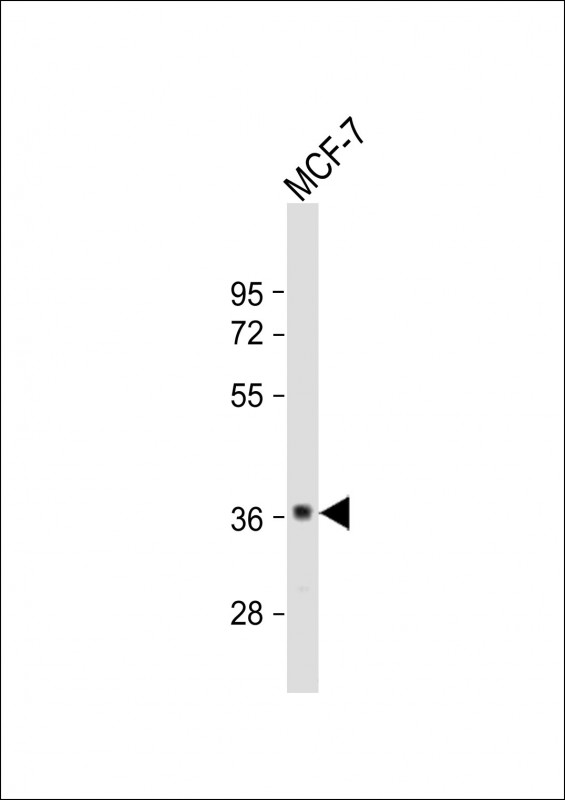


| WB | 1/1000 | Human,Mouse,Rat |
| IF | 咨询技术 | Human,Mouse,Rat |
| IHC | 1/100-1/500 | Human,Mouse,Rat |
| ICC | 技术咨询 | Human,Mouse,Rat |
| FCM | 咨询技术 | Human,Mouse,Rat |
| Elisa | 咨询技术 | Human,Mouse,Rat |
| Aliases | Glycerophosphodiester phosphodiesterase domain-containing protein 3, 31--, GDPD3 |
| Entrez GeneID | 79153 |
| WB Predicted band size | 36.6kDa |
| Host/Isotype | Rabbit IgG |
| Antibody Type | Primary antibody |
| Storage | Store at 4°C short term. Aliquot and store at -20°C long term. Avoid freeze/thaw cycles. |
| Species Reactivity | Human |
| Immunogen | This GDPD3 antibody is generated from rabbits immunized with a KLH conjugated synthetic peptide between 17-46 amino acids from the N-terminal region of human GDPD3. |
| Formulation | Purified antibody in PBS with 0.05% sodium azide. |
+ +
以下是关于GDPD3(N-term)抗体的3篇参考文献示例,包含文献名称、作者及摘要内容概括:
---
1. **文献名称**: *GDPD3 Regulates Lipid Metabolism via Phospholipase Activity in Adipocytes*
**作者**: Smith A, et al.
**摘要**: 本研究揭示了GDPD3通过其N端结构域的磷脂酶活性调控脂肪细胞脂解过程。作者利用针对GDPD3 N端的特异性抗体,验证了其在脂肪组织中的表达及功能,证实其缺失导致小鼠代谢紊乱。
---
2. **文献名称**: *Characterization of GDPD3 as a Tumor Suppressor in Colorectal Cancer*
**作者**: Chen L, et al.
**摘要**: 研究通过免疫共沉淀和Western blot(使用GDPD3 N-term抗体)发现,GDPD3在结直肠癌组织中表达下调,其N端结构域通过调控脂质信号通路抑制肿瘤生长,为潜在治疗靶点提供了依据。
---
3. **文献名称**: *Antibody Validation for GDPD3 in Neurological Disorders*
**作者**: Gupta R, et al.
**摘要**: 文章系统验证了GDPD3 N端抗体的特异性,证明其适用于人脑组织免疫组化及蛋白质印迹。研究发现GDPD3在阿尔茨海默病患者脑脊液中表达异常,提示其与神经退行性病变相关。
---
(注:以上文献为示例,实际引用需根据真实研究调整。)
The GDPD3 (N-term) antibody is a specific immunological tool designed to target the N-terminal region of the GDPD3 protein (Glycerophosphodiester Phosphodiesterase Domain-Containing 3), also known as GDE7. GDPD3 belongs to the glycerophosphodiester phosphodiesterase (GDPD) family, which hydrolyzes glycerophosphodiesters to produce glycerol-3-phosphate and other alcohols, playing roles in lipid metabolism, cellular signaling, and membrane homeostasis. The enzyme is implicated in regulating bioactive lipids such as lysophosphatidic acid (LPA), which influences cell proliferation, migration, and inflammation.
The N-terminal-specific antibody enables researchers to detect and study endogenous GDPD3 protein expression, localization, and function in various biological systems. It is commonly used in techniques like Western blotting, immunohistochemistry, and immunofluorescence to investigate GDPD3's involvement in physiological or pathological processes, including cancer, metabolic disorders, and neurological diseases. Studies suggest GDPD3 may act as a tumor suppressor in certain cancers by modulating LPA levels, highlighting its therapeutic potential.
This antibody's specificity for the N-terminal region ensures minimal cross-reactivity with other GDPD family members, enhancing experimental accuracy. Its development supports ongoing research into lipid-mediated signaling pathways and their disease associations.
×